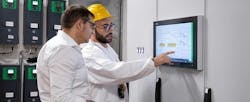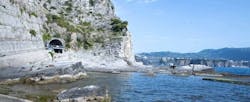Conserving Energy and the Environment: Veolia Water Technologies
Veolia Water Technologies is a global provider of water and wastewater services and solutions for both the public and private sectors. They were contracted to build a water treatment facility on the Sorrento coast, one of the most picturesque parts of Italy, that would provide critical services to local residents as well as protect the environment. The situation was serious as more than half of the population was discharging waste directly into the sea, and the other half into a treatment facility that did not comply with regulations. These challenges drove Veolia to design a state-of-the-art solution for their plant at Punta Gradelle. With sustainability being one of their key values, Veolia’s plan was not only to treat wastewater, but to also do it sustainably, reusing the recovered material for industrial and irrigation purposes. To realize these ambitions, they needed an advanced supervision system that could provide insights for efficient management across the facility as well as individual operating units. Applying a holistic approach for holistic results “Ensuring operational reliability of such a complex system, located in a tunnel, demanded a trusted technology partner. Schneider Electric, with its dedicated platform for the water sector, met this requirement,” said Gianfranco Favali, Manager of the Project Design Department at Veolia Water Technologies, Italy. Schneider’s EcoStruxure for Water & Wastewater delivered solutions for both process and energy efficiency.
The automation of the plant’s processes was based on EcoStruxure Hybrid DCS, covering the four operational areas of the facility: pre-processing, oxidation, sludge processing, electrical distribution. The automation architecture provides multiple distinct control units, an efficient, high-speed network for exchanging information between the control units, a network for data exchange between control units and their supervisors, and a central supervision system delivering information to personnel. An advanced control room interface enables operators, maintenance staff, and system engineers to access analytical insights for efficient system management, electricity distribution, and preventive and corrective maintenance. The plant’s electrical system, consisting of four cabins assigned to the facility’s four operational areas, was equipped with Schneider’s iPMCC solutions for power and motor control and energy management. These electrical panels are integrated into the site infrastructure through an intelligent communication architecture open to all main industrial networks (Ethernet TCP/IP, PROFIBUS-DP, DeviceNet, Modbus, etc.). This way, real-time data is centralized and aggregated to support decision-making on energy efficiency, equipment reliability, and maintenance.
Implementing EcoStruxure at the Punta Gradelle water treatment plant brought Veolia tangible results. “The benefits achieved are truly remarkable,” said Gianfranco Favali. “We have estimated an annual energy savings of around 15% and a 20% improvement in production efficiency.” Another area that has shown improvements is service continuity, as the plant has minimized downtime. Through high-level data analysis, Veolia is better able to perform predictive and corrective maintenance, making the whole process more efficient as crews work on priorities alerted by the system. “The quality of the results achieved from the use of this platform has fully met our needs and will be replicated on other projects,” concluded Favali
Editor's Note: Scranton Gillette Communications and the SGC Water Group are not liable for the accuracy, efficacy and validity of the claims made in this piece. The views expressed in this content do not reflect the position of the editorial teams of Water & Wastes Digest, Water Quality Products and Storm Water Solutions.

